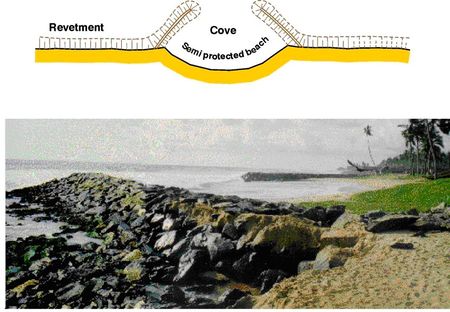Cove
Definition of Cove:
A cove is a pocket beach enclosed by structures with a small gap.
This is the common definition for Cove, other definitions can be discussed in the article
|
Cove formation
A cove beach (also called pocket beach) is a small beach between two close headlands with little or no exchange of sediment with the adjacent shorelines, see Fig. 1. Many natural pocket beaches exist throughout the world (see Embayed beaches) and artificial pocket beaches (coves) are usually constructed in areas where natural beaches are fairly narrow or absent. The construction of a cove can create a quiet recreational environment for swimming and the beach-landing of small boats. However, a cove opening that is too narrow will reduce water circulation, possibly leading to degraded water quality and the cove may trap debris and seaweed.
Artificial cove beaches form by trapping sand from the upper shoreface, as soon as the enclosing structures have been built. In some cases initial beach fill may be recommended. The formation and shape of a cove beach is fairly independent of the wave climate due to the narrow opening. Cove beaches are similar to beaches formed behind narrow gaps of segmented breakwaters.
Applicability
Cove construction as beach protection measure is especially suited for coasts with oblique wave attack and for locations with steep coastal profiles[1]. This type of coast is often susceptible to erosion and protected by revetments because of strong littoral transport. Soft protection measures such as shore nourishment are less suitable in this case due to high maintenance requirements. Stabilizing the coast with a field of groynes is also problematic as oblique wave incidence causes strong gradients in the littoral transport around groynes. The cove shown in Fig. 1 may change a small coastal section protected by a revetment into an attractive recreational environment.
Equilibrium planform
The planform of cove beaches is mainly determined by the wave diffraction pattern around the headland extremities, assuming that the wave breaking zone is situated seaward of the cove. If the gap width [math]B[/math] between the headlands is sufficiently small (much smaller than the wavelength [math]L[/math]), sand exchange through the gap is minimized after adjustment of the beach planform to the wave diffraction pattern. The resulting equilibrium beach planform depends mainly on the wavelength [math]L[/math] of the incident waves at the gap and on the gap width [math]B[/math]. Field observations of (mostly artificial) cove beaches with a small gap width on the Balearic and Canary islands, the Spanish Mediterranean and Atlantic coasts and the Portuguese and Brazilian Atlantic coasts, show strong similarity of planform shapes. The planform shape of these cove beaches (Fig. 2) can be represented by the empirical formulas[2]
[math]\Large\frac{R(\theta)}{R_0}\normalsize = (1 - \beta \cot \beta +\alpha)+ (\beta \cot \beta - 2 \alpha ) \Big( \Large\frac{\beta}{\theta}\normalsize \Big) +\alpha \Big( \Large\frac{\beta}{\theta}\normalsize \Big)^2 , \qquad (1)[/math]
[math]R_0 = \Large\frac{B}{2 \sin \beta}\normalsize, \quad \alpha = 0.277 - 0.0785 \; 10^{(\beta - \phi)} , \quad \phi = 0.33 \, \Big( 1 + e^{-17(\beta - \large\frac{\pi}{4}\normalsize)} \Big)^{-8270} \qquad (2) [/math]
and
[math]\Large\frac{R(\theta=\pi)}{R_0}\normalsize \approx 0.53\, \sin \beta \Big( \Large\frac{R_0}{L}\normalsize \Big)^{0.1} . \qquad (3)[/math]
The particular form of Eq. (1) is to satisfy the conditions [math]R(\beta)=R_0[/math] and [math]\Large\frac{dR}{d \beta}\normalsize (\theta=\beta) = 0[/math].
Related articles
References
- ↑ Mangor, K., Drønen, N. K., Kaergaard, K.H. and Kristensen, N.E. 2017. Shoreline management guidelines. DHI https://www.dhigroup.com/marine-water/ebook-shoreline-management-guidelines
- ↑ Elshinnawy, A.I., Medina, R. and Gonzalez, M. 2022. Equilibrium planform of pocket beaches behind breakwater gaps: On the shape of the equilibrium shoreline. Coastal Engineering 174, 104112
Please note that others may also have edited the contents of this article.
|

